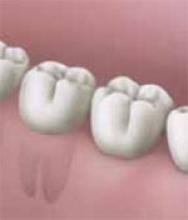THE QUESTION:
Does periodontal disease cause preterm birth?
Past studies:
Research has suggested that chronic periodontal infection may be associated with preterm birth.
This study:
A total of 1,313 pregnant women were recruited from the Perinatal Research Center at the University of Alabama in Birmingham. Gravidas had a complete medical and periodontal workup between 21 and 24 weeks’ gestation. After determining gestational age at delivery, the researchers calculated the relationship between periodontal disease and preterm birth, adjusting for smoking, parity, race, and maternal age.
Based on these findings, the authors concluded that preexisting periodontal disease in the second trimester of pregnancy increases the risk of preterm birth. In fact, a patient’s risk increases 4.5-fold for delivery before 37 weeks’ gestation to 7-fold for delivery prior to 32 weeks, depending on the severity of the disease.
Find this study:
July 2001 issue of The Journal of the American Dental Association; abstract online at www.ada.org/prof/pubs/jada/index.asp.
Who may be affected by these findings?
Gravidas with periodontal infections and/or disease.
Expert commentary:
Many dental practitioners would opine that dental caries and significant periodontal disease in early adulthood are markers of poverty. Interestingly, many studies on preterm birth have drawn similar conclusions, especially with regard to bacterial vaginosis (BV). Not only does BV seem to be associated with a higher rate of preterm birth, but studies also suggest that the infection may be more prevalent in lower socioeconomic groups. Therefore, it is important to examine socioeconomic status when determining the association between periodontal disease and preterm birth. In this study, the researchers raised a number of important issues. Unfortunately, socioeconomic status was not among them. Interestingly, 82% of the study population was African American. In the United States, African Americans have a higher incidence of preterm delivery (PTD) than either the Caucasian or Hispanic populations. Therefore, the value of determining whether preterm birth is attributable to periodontal disease is suspect, unless it is used as a proxy for representing African Americans in a lower socioeconomic group. Perhaps it would be best to determine whether periodontal disease has the same association with prematurity across all US populations in order to determine whether the correlation is magnified in the lower socioeconomic groups.
Until we can eliminate poverty, obstetricians will have to continue to deal with the problems of low birth weight and prematurity.
What then can we conclude from the data? The relationship between periodontal disease and preterm birth is undeniable. Even more compelling is the notion of increasing prematurity with regard to the severity of periodontal disease. However, the authors firmly stated that it is still unknown whether treating periodontal disease will reduce the risk of preterm delivery, a finding that is reminiscent of studies of bacterial vaginosis and preterm birth. The only conclusion we can draw from this study is that periodontal disease should be avoided. Further, I would submit that poor dental hygiene in young women is a marker for poverty, and therein lies the greatest risk factor for PTD. Until we can eliminate poverty, obstetricians will have to continue to deal with the problems of low birth weight and prematurity.
There is one other potential confounder worth mentioning: the contribution of other bacteria to the etiology of prematurity. Hill suggested that both oral and genital microflora may contribute to preterm birth.1 If this observation is correct, it would seem that any intervention trial would need to take into account colonization in both the oral and genital sites.
The bottom line:
Like many issues in medicine, prevention ultimately works better than treatment. Therefore, preventing periodontal disease or, at least, identifying and treating it at its earliest stages is the best approach. All Ob/Gyns should discuss dental hygiene with their patients to better assess preventive and treatment measures.


